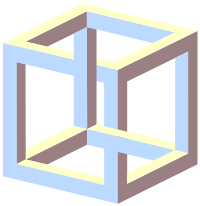Difference between revisions of "Impossible cube" - New World Encyclopedia
(Copied from wikipedia) |
(started) |
||
| Line 1: | Line 1: | ||
| − | {{Claimed}} | + | {{Claimed}}{{Started}} |
[[Category:Politics and social sciences]] | [[Category:Politics and social sciences]] | ||
[[Category:Psychology]] | [[Category:Psychology]] | ||
| Line 11: | Line 11: | ||
In [[M.C. Escher]]'s lithograph ''[[Belvedere (M. C. Escher)|Belvedere]]'', the figure of a boy seated at the foot of the building is holding an impossible cube; the rest of the scene is based on the same principle that makes the impossible cube. In the scene, a ladder from the inside of the first story leads to the ''outside'' of the second. However, this is not appreciated by the prisoner in the basement cell because the basement is a ''possible'' [[cuboid]] and he is unambiguously on the inside. | In [[M.C. Escher]]'s lithograph ''[[Belvedere (M. C. Escher)|Belvedere]]'', the figure of a boy seated at the foot of the building is holding an impossible cube; the rest of the scene is based on the same principle that makes the impossible cube. In the scene, a ladder from the inside of the first story leads to the ''outside'' of the second. However, this is not appreciated by the prisoner in the basement cell because the basement is a ''possible'' [[cuboid]] and he is unambiguously on the inside. | ||
| − | A doctored photograph purporting to be of an impossible cube was published in the June | + | A doctored photograph purporting to be of an impossible cube was published in the June 1966 issue of ''[[Scientific American]]'', where it was called a "Freemish Crate." |
| + | |||
| − | |||
Revision as of 00:17, 6 September 2007
The impossible cube or irrational cube is an impossible object that draws upon the ambiguity present in a Necker cube illustration. An impossible cube is usually rendered as a Necker cube in which the edges are apparently solid beams. This apparent solidity gives the impossible cube greater visual ambiguity than the Necker cube, which is less likely to be perceived as an impossible object. The illusion plays on the human eye's interpretation of two-dimensional pictures as three-dimensional objects.
In M.C. Escher's lithograph Belvedere, the figure of a boy seated at the foot of the building is holding an impossible cube; the rest of the scene is based on the same principle that makes the impossible cube. In the scene, a ladder from the inside of the first story leads to the outside of the second. However, this is not appreciated by the prisoner in the basement cell because the basement is a possible cuboid and he is unambiguously on the inside.
A doctored photograph purporting to be of an impossible cube was published in the June 1966 issue of Scientific American, where it was called a "Freemish Crate."
Credits
New World Encyclopedia writers and editors rewrote and completed the Wikipedia article in accordance with New World Encyclopedia standards. This article abides by terms of the Creative Commons CC-by-sa 3.0 License (CC-by-sa), which may be used and disseminated with proper attribution. Credit is due under the terms of this license that can reference both the New World Encyclopedia contributors and the selfless volunteer contributors of the Wikimedia Foundation. To cite this article click here for a list of acceptable citing formats.The history of earlier contributions by wikipedians is accessible to researchers here:
The history of this article since it was imported to New World Encyclopedia:
Note: Some restrictions may apply to use of individual images which are separately licensed.

